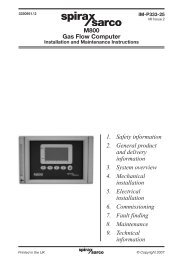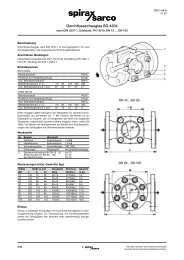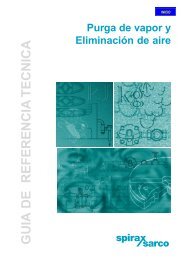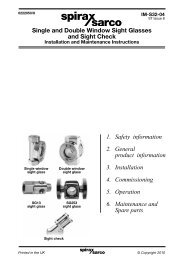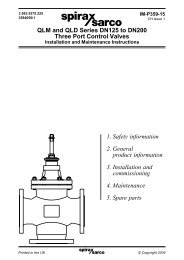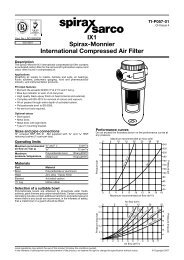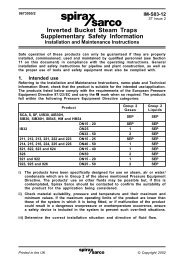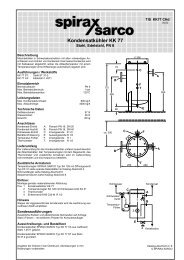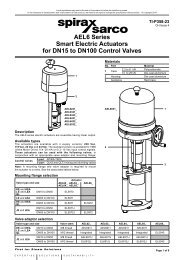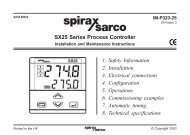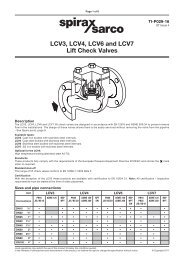STS17.2 Stainless Steel Compact Pipeline Connector ... - Spirax Sarco
STS17.2 Stainless Steel Compact Pipeline Connector ... - Spirax Sarco
STS17.2 Stainless Steel Compact Pipeline Connector ... - Spirax Sarco
Create successful ePaper yourself
Turn your PDF publications into a flip-book with our unique Google optimized e-Paper software.
1289050/5<br />
IM-P128-23<br />
ST Issue 5<br />
<strong>STS17.2</strong><br />
<strong>Stainless</strong> <strong>Steel</strong><br />
<strong>Compact</strong> <strong>Pipeline</strong> <strong>Connector</strong> Steam Trapping Station<br />
Installation and Maintenance Instructions<br />
Single upstream isolation<br />
1. Safety information<br />
2. General<br />
product information<br />
3. Installation<br />
Double upstream isolation<br />
4. Commissioning<br />
5. Maintenance<br />
6. Spare parts<br />
© Copyright 2012<br />
IM-P128-23 ST Issue 5 1<br />
Printed in the UK
2<br />
IM-P128-23 ST Issue 5
1. Safety information<br />
Safe operation of these products can only be guaranteed if they are properly installed,<br />
commissioned, used and maintained by qualified personnel (see Section 1.11) in<br />
compliance with the operating instructions. General installation and safety instructions<br />
for pipeline and plant construction, as well as the proper use of tools and safety<br />
equipment must also be complied with.<br />
1.1 Intended use<br />
Referring to the Installation and Maintenance Instructions, name-plate and Technical<br />
Information Sheet, check that the product is suitable for the intended use/application.<br />
The products listed below comply with the requirements of the European Pressure<br />
Equipment Directive 97/23/EC and carry the mark when so required. The products<br />
fall within the following Pressure Equipment Directive categories:<br />
Group 1 Group 2 Group 1 Group 2<br />
Product<br />
Gases Gases Liquids Liquids<br />
<strong>STS17.2</strong> DN15 - DN25 - SEP - SEP<br />
i) The <strong>STS17.2</strong> has been specifically designed for use on steam and condensate<br />
that is in Group 2 of the above mentioned pressure equipment directive.<br />
For use on other fluids contact <strong>Spirax</strong> <strong>Sarco</strong> to confirm suitability of the product<br />
for the application being considered.<br />
ii) Check material suitability, pressure and temperature and their maximum and<br />
minimum values. If the maximum operating limits of the product are lower than<br />
those of the system in which it is being fitted, or if malfunction of the product could<br />
result in a dangerous overpressure or overtemperature occurrence, ensure a safety<br />
device is included in the system to prevent such over-limit situations.<br />
iii) Determine the correct installation situation and direction of fluid flow.<br />
i v ) S p i r a x S a r c o p r o d u c t s a r e n o t i n t e n d e d t o w i t h s t a n d e x t e r n a l s t r e s s e s t h a t m a y<br />
be induced by any system to which they are fitted. It is the responsibility of the<br />
installer to consider these stresses and take adequate precautions to minimise<br />
them.<br />
v) Remove protection covers from all connections and protective film from all<br />
name-plates, where appropriate, before installation on steam or other high<br />
temperature applications.<br />
1.2 Access<br />
Ensure safe access and if necessary a safe working platform (suitably guarded)<br />
before attempting to work on the product. Arrange suitable lifting gear if required.<br />
1.3 Lighting<br />
Ensure adequate lighting, particularly where detailed or intricate work is required.<br />
IM-P128-23 ST Issue 5 3
1.4 Hazardous liquids or gases in the pipeline<br />
Consider what is in the pipeline or what may have been in the pipeline at some<br />
previous time. Consider: flammable materials, substances hazardous to health,<br />
extremes of temperature.<br />
1.5 Hazardous environment around the product<br />
Consider: explosion risk areas, lack of oxygen (e.g. tanks, pits), dangerous gases,<br />
extremes of temperature, hot surfaces, fire hazard (e.g. during welding), excessive<br />
noise, moving machinery.<br />
1.6 The system<br />
Consider the effect on the complete system of the work proposed. Will any proposed<br />
action (e.g. closing isolation valves, electrical isolation) put any other part of the<br />
system or any personnel at risk?<br />
Dangers might include isolation of vents or protective devices or the rendering<br />
ineffective of controls or alarms. Ensure isolation valves are turned on and off in<br />
a gradual way to avoid system shocks.<br />
1.7 Pressure systems<br />
Ensure that any pressure is isolated and safely vented to atmospheric pressure.<br />
Consider double isolation (double block and bleed) and the locking or labelling of<br />
closed valves. Do not assume that the system has depressurised even when the<br />
pressure gauge indicates zero.<br />
1.8 Temperature<br />
Allow time for temperature to normalise after isolation to avoid danger of burns.<br />
Valves which are fitted with PTFE seats must not be subjected to temperatures<br />
above 260°C (500°F). Above these temperatures toxic fumes may be given off.<br />
Avoid inhalation of fumes or skin contact.<br />
1.9 Tools and consumables<br />
Before starting work ensure that you have suitable tools and/or consumables<br />
available. Use only genuine <strong>Spirax</strong> <strong>Sarco</strong> replacement parts.<br />
1.10 Protective clothing<br />
Consider whether you and/or others in the vicinity require any protective clothing<br />
to protect against the hazards of, for example, chemicals, high / low temperature,<br />
radiation, noise, falling objects, and dangers to eyes and face.<br />
1.11 Permits to work<br />
All work must be carried out or be supervised by a suitably competent person.<br />
Installation and operating personnel should be trained in the correct use of the<br />
product according to the Installation and Maintenance Instructions.<br />
Where a formal 'permit to work' system is in force it must be complied with. Where<br />
there is no such system, it is recommended that a responsible person should know<br />
what work is going on and, where necessary, arrange to have an assistant whose<br />
primary responsibility is safety.<br />
Post 'warning notices' if necessary.<br />
4<br />
IM-P128-23 ST Issue 5
1.12 Handling<br />
Manual handling of large and/or heavy products may present a risk of injury. Lifting,<br />
pushing, pulling, carrying or supporting a load by bodily force can cause injury<br />
particularly to the back. You are advised to assess the risks taking into account the<br />
task, the individual, the load and the working environment and use the appropriate<br />
handling method depending on the circumstances of the work being done.<br />
1.13 Residual hazards<br />
In normal use the external surface of the product may be very hot. If used at the<br />
maximum permitted operating conditions the surface temperature of some products<br />
may reach temperatures of 230°C (446°F).<br />
Many products are not self-draining. Take due care when dismantling or removing<br />
the product from an installation (refer to 'Maintenance instructions').<br />
1.14 Freezing<br />
Provision must be made to protect products which are not self-draining against<br />
frost damage in environments where they may be exposed to temperatures below<br />
freezing point.<br />
1.15 Disposal<br />
Unless otherwise stated in the Installation and Maintenance Instructions,<br />
this product is recyclable and no ecological hazard is anticipated with its disposal<br />
providing due care is taken. However, the product is fitted with PTFE seats,<br />
special care must be taken to avoid potential health hazards associated with<br />
decomposition / burning of these seats.<br />
PTFE:<br />
- Can only be disposed of by approved methods, not incineration.<br />
- Keep PTFE waste in a separate container, do not mix it with other rubbish, and<br />
consign it to a landfill site.<br />
1.16 Returning products<br />
Customers and stockists are reminded that under EC Health, Safety and<br />
Environment Law, when returning products to <strong>Spirax</strong> <strong>Sarco</strong> they must provide<br />
information on any hazards and the precautions to be taken due to contamination<br />
residue's or mechanical damage which may present a health, safety or<br />
environmental risk. This information must be provided in writing including<br />
Health and Safety data sheets relating to any substances identified as hazardous<br />
or potentially hazardous.<br />
IM-P128-23 ST Issue 5 5
2. General product information<br />
2.1 Description<br />
The <strong>STS17.2</strong> compact pipeline connector steam trapping station has been designed to provide<br />
a convenient ready to install trapping solution, which includes: upstream and downstream<br />
isolation valves (2), body incorporating quickfit connector + strainer (1) and check valve (16).<br />
Available types<br />
The <strong>STS17.2</strong> is available with either single or double upstream isolation.<br />
The <strong>STS17.2</strong> trapping solution incorporates <strong>Spirax</strong> <strong>Sarco</strong> quickfit technology, which allows<br />
speedy trap maintenance. The following swivel connector steam traps (sold separately) can<br />
be used with this pipeline connector enabling it to be tailored to suit any application:<br />
- UTD30 and UTD52 thermodynamic steam traps.<br />
- UBP32 balanced pressure steam trap.<br />
- USM bimetallic steam trap.<br />
- UFT32 ball float steam trap.<br />
- UIB30 and UIB30H inverted bucket steam traps.<br />
Standards<br />
These products fully comply with the requirements of the European Pressure Equipment<br />
Directive 97 / 23 / EC.<br />
Certification<br />
These products are available with certification to EN 10204 3.1. Note: All certification /<br />
inspection requirements must be stated at the time of order placement. For other certification<br />
contact <strong>Spirax</strong> <strong>Sarco</strong>.<br />
Note: For additional product information see Technical Information Sheet TI-P128-22.<br />
Optional extras<br />
Integral sensor type SSL1 (steam only) or WLSL1 (for waterlogging) for use with R1C<br />
or WLSL1 with DIODE for use with RI6C are available as optional extras, to enable<br />
operational monitoring of the steam trap.<br />
BDV1 blowdown valve is also available for cleaning the strainer during operation.<br />
Care should be taken when using the BDV1 blowdown valve as the discharge may be hot.<br />
Please note that a BDV1 cannot be used when a Spiratec sensor has been chosen to be<br />
part of the unit.<br />
Retrofit double isolation valve and spool piece to convert a single upstream isolation<br />
version to double isolation.<br />
Insulation jacket is available to reduce heat loss and energy wastage. See separate literature.<br />
2.2 Sizes and pipe connections<br />
½", ¾" and 1" screwed BSP, NPT or socket weld.<br />
½", ¾" and 1" ASME 150 and ASME 300.<br />
DN15, DN20 and DN25 flanged EN 1092 PN40.<br />
6<br />
IM-P128-23 ST Issue 5
<strong>STS17.2</strong> version<br />
with single upstream isolation<br />
Upstream isolation<br />
valve<br />
2<br />
3<br />
Downstream isolation<br />
valve<br />
1<br />
16<br />
3<br />
2<br />
<strong>STS17.2</strong> version<br />
with double upstream isolation<br />
Strainer<br />
19<br />
Upstream isolation<br />
valve<br />
2<br />
3<br />
Upstream isolation<br />
valve<br />
2<br />
3<br />
Downstream isolation<br />
valve<br />
2<br />
16<br />
3<br />
2<br />
Strainer<br />
19<br />
Optional<br />
BDV1<br />
blowdown<br />
valve<br />
Fig. 1<br />
WLSL1<br />
integral<br />
sensor<br />
SSL1<br />
integral<br />
sensor<br />
IM-P128-23 ST Issue 5 7
2.3 Pressure/temperature limits<br />
Pressure psi g<br />
Temperature °C<br />
A<br />
Steam<br />
saturation<br />
curve<br />
D<br />
B<br />
C<br />
Temperature °F<br />
Pressure bar g<br />
System design conditions<br />
PN40<br />
PMA Maximum allowable pressure 40 bar g @ 120°C (580 psi g @ 248°F)<br />
TMA Maximum allowable temperature 230°C @ 10 bar g (446°F @ 145 psi g)<br />
Minimum allowable temperature -10°C (14°F)<br />
Maximum operating ASME 150 13.6 bar g (197 psi g)<br />
PMO pressure for saturated<br />
steam service All other connections 17.5 bar g (294 psi g)<br />
TMO Maximum operating temperature 230°C @ 10 bar g (446°F @ 145 psi g)<br />
Minimum operating temperature -10°C (14°F)<br />
Designed for a maximum cold<br />
hydraulic test pressure of:<br />
The product must not be used in this region.<br />
A - B Flanged ASME Class 300, screwed and socket weld.<br />
A - C Flanged EN 1092 PN40.<br />
A - D Flanged ASME Class 150.<br />
60 bar g (870 psi g)<br />
8<br />
IM-P128-23 ST Issue 5
3. Installation<br />
Note: Before actioning any installation observe the 'Safety information' in Section 1.<br />
Referring to the Installation and Maintenance Instructions, name-plate and Technical<br />
Information Sheet, check that the product is suitable for the intended installation:<br />
3.1 Check materials, pressure and temperature and their maximum values. If the maximum<br />
operating limit of the product is lower than that of the system in which it is being fitted,<br />
ensure that a safety device is included in the system to prevent overpressurisation.<br />
3.2 Ensure that the directional arrows on the steam trapping station are pointing in the<br />
same direction as the fluid flow within the pipeline.<br />
3.3 Remove protection covers from all connections and protective film from all<br />
name-plates, where appropriate, before installation on steam or other high<br />
temperature applications.<br />
3.4 Make sure that there will be sufficient access for a steam trap to be fitted to the<br />
connector, once the trapping station is installed within the pipeline.<br />
3.5 Although the steam trapping station has great structural integrity, severe misalignment<br />
and/or the pulling effect of incorrect pipe length will have a detrimental effect on the<br />
unit and must be avoided. Particular attention should be paid to correct pipe alignment<br />
such that the inlet pipework and valve are all on the same axis.<br />
3.6 Care must be taken to ensure any dirt in the connecting pipework is removed before<br />
installation, maintain cleanliness during installation since the introduction of dirt can<br />
result in damage to the seats within the isolation valves.<br />
3.7 To install socket welded versions the following procedure should be followed:<br />
- Dismantle the end caps from the body.<br />
- Remove the PTFE seats.<br />
- Weld each end cap to the pipeline.<br />
- Replace the PTFE seats.<br />
- Reassemble.<br />
3.8 Select a quickfit connector steam trap suitable for the application and fit it to the<br />
steam trap station using the guidance provided within the Installation and<br />
Maintenance Instructions provided with the chosen product.<br />
IM-P128-23 ST Issue 5 9
3.9 The <strong>STS17.2</strong> can be installed in a horizontal line, or in a vertical line with flow<br />
downwards - See Figure 2.<br />
The <strong>STS17.2</strong> MUST NOT be fitted in a vertical line with the flow upwards -<br />
See Figure 3.<br />
Horizontal<br />
flow<br />
4<br />
Vertical flow<br />
downwards<br />
7Vertical flow<br />
Fig. 3<br />
upwards<br />
Fig. 2<br />
4<br />
3.10 Welding into pipeline of socket weld variants<br />
A universal weld procedure covering the requirements of different National and<br />
International Standards and practices is difficult to provide - specifically regarding the<br />
welding procedure, welding conditions (run number, consumable size, current, voltage,<br />
polarity), storage of consumables and make / type of consumables due to the abundance<br />
of appropriate consumable suppliers.<br />
Therefore, the information given in Section 3.10.1, is only advice based on British<br />
Standards to be used for guidance on the essential requirements of welding socket<br />
weld <strong>STS17.2</strong> trap stations into the pipeline.<br />
This will allow a user to select an appropriate weld procedure from those available<br />
to that user.<br />
This advice is not intended to be a substitute for a weld procedure: it is for<br />
guidance only.<br />
10<br />
IM-P128-23 ST Issue 5
3.10.1 Welding of an <strong>STS17.2</strong> steam trap station<br />
The welding of an <strong>STS17.2</strong> steam trap station ½", ¾" and 1" socket weld<br />
to a 15 mm, 20 mm or 25 mm Schedule 40 pipe<br />
Parent materials(s)<br />
Description<br />
Austenitic stainless steel with minimum tensile<br />
strength up to and including 485 N/mm²<br />
Specification(s)<br />
ASTM A182 F316L (<strong>STS17.2</strong>)<br />
ASTM A106 Gr. B (Pipe)<br />
Material group(s)<br />
R<br />
A1<br />
Joint type<br />
Socket joint to BS 3799 Class 3000 lb<br />
Welding process<br />
Manual Metal Arc (MMA)<br />
Parent materials(s) dimensions<br />
Thickness O/D<br />
(mm) (mm)<br />
½"<br />
<strong>STS17.2</strong> 5.15 32.00<br />
Pipe 2.76 21.30<br />
¾"<br />
<strong>STS17.2</strong> 5.00 37.00<br />
Pipe 2.87 26.70<br />
1"<br />
<strong>STS17.2</strong> 5.60 45.00<br />
Pipe 3.38 33.40<br />
Pipe is to be BS 1600 Schedule 40<br />
Weld preparation<br />
Dimensioned sketch<br />
Welding positions(s)<br />
All: Site welded<br />
Welding consumables<br />
Filler material:<br />
Composition - Low C: 23% Cr: 12 % Ni:<br />
Specification - BS 2926: 1984: 23-12 L BR<br />
Shielding gas/ flux:<br />
Not applicable<br />
<strong>STS17.2</strong><br />
t<br />
Pipe<br />
1.5 mm approximately<br />
Diametrical clearance 1.0 mm maximum<br />
Reference - BS 2633: 1987: Section 3.1 and Fig. 9<br />
Method of preparation and<br />
cleaning<br />
Socket: As supplied and wire brushed<br />
Pipe: Mechanically cut and wire brushed<br />
Additional information<br />
1. See Section 3.7, page 9.<br />
2. Fit-up using tack welds.<br />
Parent material temperature<br />
Preheat temperature<br />
Only required when ambient is below 5°C<br />
(41°F), then "warm to touch"<br />
Interpass temperature<br />
Not applicable<br />
Post-weld<br />
heat treatment<br />
None required<br />
Run sequence and completed<br />
weld dimensions<br />
Sketch<br />
This edge<br />
not to be completely melted away<br />
<strong>STS17.2</strong><br />
1.4t minimum<br />
Pipe<br />
Reference.- BS 806: 1990: Section 4: Clause 4.7.3<br />
lll<br />
1.4t minimum<br />
3.9.2 Select a quickfit connector steam trap suitable for the application and fit to the<br />
<strong>STS17.2</strong> using the guidance provided within the Installation and Maintenance<br />
Instructions provided with the steam trap.<br />
IM-P128-23 ST Issue 5 11
4. Commissioning<br />
After installation ensure that the system is fully functioning. Carry out tests on any alarms<br />
or protective devices. Open isolating valves slowly and ensure that there are no leaks.<br />
5. Maintenance<br />
Note: Before actioning any maintenance programme observe<br />
the 'Safety information' in Section 1.<br />
5.1 Introduction<br />
All work must be carried out by a suitably competent person. Before starting work ensure<br />
that suitable tools are available. Use only <strong>Spirax</strong> <strong>Sarco</strong> replacement parts.<br />
5.2 Maintenance<br />
Some maintenance can be completed with the steam trap station in the pipeline, once<br />
the safety procedures have been observed. It is recommended that new gaskets and spares<br />
are used whenever maintenance is undertaken. Ensure that the correct tools and necessary<br />
protective equipment are used at all times. When maintenance is complete open isolation<br />
valves slowly and check for leaks.<br />
5.3 How to replace the strainer screen:<br />
- Before starting any maintenance work make sure that the steam trap station is isolated<br />
from the mains pressure (both steam and condensate) and that any residual pressure<br />
is vented to atmosphere. Allow to cool before commencing work.<br />
- Remove the strainer cap (19) with sensor (23 and 24 i f fi t t e d ) e n s u r i n g c a b l e s a r e<br />
not damaged (WLSL1) or optional blowdown valve (25 and 26) and separate it from the<br />
strainer screen (22).<br />
- Once the strainer screen (22) has been cleaned or replaced, place it in the recess of the<br />
strainer cap (19 or 20).<br />
- Using a new cap gasket (21) replace the strainer screen and cap into the body of the<br />
<strong>STS17.2</strong> and loosely tighten to ensure the screen and gasket locate correctly.<br />
- Tighten to the recommended torque (see Table 1).<br />
- Ensure sensor cables are not twisted and are secure.<br />
- Recommission and ensure that there are no leaks.<br />
5.4 How to blowdown the strainer screen:<br />
(models fitted with blowdown valve only)<br />
- Periodic blowdown will remove most debris within the strainer screen. Larger debris<br />
may require the whole screen to be removed as detailed in Section 5.3.<br />
- The BDV1 blowdown valve fitted to the <strong>STS17.2</strong> has an integral valve screw (26), which<br />
can be unscrewed with a 17 mm A/F spanner to blowdown the strainer screen. A lockset<br />
screw will prevent the integral valve screw from disengaging from the valve body (25). A<br />
torque of 22 - 25 N m (16 - 17 lbf ft) is recommended for resealing the integral valve screw.<br />
Warning: Ensure that adequate safety precautions have been taken when opening the<br />
blowdown valve to atmosphere.<br />
For full technical details of the BDV1 see IM-P600-02.<br />
12<br />
IM-P128-23 ST Issue 5
<strong>STS17.2</strong> version<br />
with double upstream isolation<br />
Fig. 4<br />
19<br />
Standard<br />
22<br />
21<br />
20<br />
Adaptor<br />
Lockset screw<br />
20<br />
Adaptor<br />
24<br />
25<br />
26<br />
BDV1<br />
blowdown<br />
valve<br />
20<br />
Adaptor<br />
23<br />
SSL1<br />
integral<br />
sensor<br />
WLSL1<br />
integral sensor<br />
Table 1 Recommended tightening torques<br />
Item<br />
or<br />
Torque<br />
mm<br />
N m<br />
lbf ft<br />
19 32 A/F M28 x ISP 170 - 190 126 - 140<br />
20 Adaptor 32 A/F M28 x ISP 170 - 190 126 - 140<br />
23 19 A/F 50 - 55 37 - 40<br />
24 24 A/F 50 - 55 37 - 40<br />
25 24 A/F Not applicable Not applicable<br />
26 17 A/F 22 - 25 16 - 18<br />
IM-P128-23 ST Issue 5 13
5.5 How to replace or clean the sensor:<br />
- Before starting any maintenance work make sure that the steam trap station is isolated<br />
from the mains pressure (both steam and condensate) and that any residual pressure is<br />
vented to atmosphere. Allow to cool before commencing work.<br />
- If a waterlogging sensor is fitted (WLSL1), it will be necessary to disconnect the wiring<br />
at the terminal block. Remove the sensor (23 or 24) from the adaptor (20). (This can be<br />
done in line so long as the adaptor is securely held in place).<br />
- Clean the sensor insulation. If pitting of the insulation has occured, a new sensor should<br />
be fitted.<br />
- Clean or replace the strainer screen (22) (whichever action is appropriate for the<br />
condition of the screen).<br />
- Replace the new or cleaned sensor (23 or 24) and screw it into the adaptor (20),<br />
ensuring that the gasket (21) and strainer screen (22) are centralised.<br />
- Tighten to the recommended torque, see Table 2.<br />
- Reconnect the waterlogging sensor as described in IM-P087-34.<br />
5.6 How to replace the check valve<br />
Using a 32 mm A / F spanner, unscrew and remove the check valve blanking plug (16). You<br />
can now see the check valve assembly (17) inside the body. A long 20 mm A/F socket is<br />
required to unscrew the check valve (17) from the body.<br />
Replace with a new check valve assembly (17) and tighten to the recommended torque:<br />
110 - 120 N m (81 - 88 lbf ft).<br />
Using a new gasket (18), replace the check valve blanking plug (16) and tighten to the<br />
recommended torque, see Table 2.<br />
5.7 How to replace the ball valve spares (reference Figure 5):<br />
Maintenance work can be carried out without removing the complete ball valve from the<br />
pipeline. Remove the two upper bolts and nuts (12 + 13) and then loosen the lower<br />
two (14 + 15). The complete body assembly (2) can can then be removed and any new<br />
parts fitted.<br />
Renewal of seats:<br />
1. Remove the body as described above.<br />
2. With body removed, remove the seats (8).<br />
3. Fit new seats, pushing them into the body recesses.<br />
Renewal of the stem seals<br />
1. Remove body as described above.<br />
2. Remove nuts (5 and 11) and the belleville washers (10).<br />
3. Replace stem seals (9).<br />
Reassembly<br />
Reassemble in reverse order to instructions given above. The ball valve bolts and<br />
nuts (12 + 13 and 14 + 15) should be tightened to the recommended torques shown in<br />
Table 2, page 15.<br />
14<br />
IM-P128-23 ST Issue 5
<strong>STS17.2</strong> version<br />
with single upstream isolation<br />
16<br />
18<br />
17<br />
13<br />
5<br />
10<br />
11 9<br />
8<br />
12<br />
22<br />
15<br />
21<br />
8<br />
20<br />
2<br />
14<br />
20<br />
20<br />
25 26<br />
Fig. 5<br />
WLSL1<br />
integral<br />
sensor<br />
24<br />
23<br />
SSL1<br />
integral<br />
sensor<br />
BDV1<br />
blowdown<br />
valve<br />
Table 2 Recommended tightening torques<br />
Item<br />
or<br />
Torque<br />
mm<br />
N m<br />
lbf ft<br />
5 and 11<br />
½" and ¾" 13 5.4 - 8.1 4 - 6<br />
1" 14 10.8 - 13.5 8 - 10<br />
12, 14 and 13, 15 M6 15 - 17 11 - 12<br />
16 32 A/F M35 x 1.5 190 - 200 140 - 147<br />
20 Adaptor 32 A/F M28 x ISP 170 - 190 126 - 140<br />
23 19 A/F 50 - 55 37 - 40<br />
24 24 A/F 50 - 55 37 - 40<br />
25 24 A/F Not applicable Not applicable<br />
26 17 A/F 22 - 25 16 - 18<br />
IM-P128-23 ST Issue 5 15
5.8 How to fit a double isolation conversion kit<br />
- A retrofit kit is available to convert a standard single isolation <strong>STS17.2</strong> to a double<br />
isolation (upstream) version. The double isolation conversion kit includes a spool piece<br />
and additional ball valve parts.<br />
- Remove the bolts and nuts (12 + 13) and remove the upstream end cap (6).<br />
- Attach the spool piece (27) using the new bolts supplied with the conversion kit in combination<br />
with the existing nuts (12 + 13 and 14 + 15) and tighten to the recommended torque (see<br />
Table 3).<br />
- Loosely assemble the existing end cap (6) to the other end of the spool piece (27)<br />
using the new nuts supplied with the conversion kit in combination with the existing<br />
bolts (12 + 13 and 14 + 15), allowing enough gap to slide in the new ball valve and body<br />
assembly (2).<br />
- Slide in the new ball valve and body assembly (2) between the spool piece (27) and<br />
end cap (6) and tighten the bolts and nuts (12 + 13 and 14 + 15) to the recommended<br />
torque (see Table 3).<br />
- Fit the new handle (3) onto the spindle of the new ball valve assembly (2), ensuring it<br />
is in the correct orientation and secure in place by fitting the washer and nut (4 + 5) and<br />
tighten firmly.<br />
12 6 2<br />
13<br />
14<br />
X is a double isolation<br />
conversion kit<br />
15<br />
5<br />
4<br />
3<br />
13 12 27<br />
2<br />
15<br />
14<br />
Fig. 6 How to fit a double isolation conversion kit to a single isolation valve<br />
16<br />
IM-P128-23 ST Issue 5
Table 3 Recommended tightening torques<br />
or<br />
Torque<br />
Item<br />
mm<br />
N m<br />
lbf ft<br />
½" and ¾" 13 5.4 - 8.1 4 - 6<br />
5<br />
1" 14 10.8 - 13.5 8 - 10<br />
12, 14 and 13, 15 M6 15 - 17 11 - 12<br />
IM-P128-23 ST Issue 5 17
6. Spare parts<br />
Spare parts<br />
The spare parts are available as indicated below. No other parts are supplied as spares.<br />
Available spares<br />
Isolation ball valve seat and stem seals 8, 9<br />
Strainer screen and gasket 21, 22<br />
Spare sensor SSL1 Spiratec sensor 23<br />
and sensor gasket WLSL1 diode waterlogging sensor 24<br />
Spiratec retrofit kit<br />
Note: State whether an SSL1 or<br />
WLSL1 sensor is required.<br />
20, 21 + 23 or 24<br />
Check valve assembly 17, 18<br />
Double isolation conversion kit (includes spool piece and additional isolation valve) X<br />
BDV1 blowdown valve retrofit kit 20, 21 + 25<br />
How to order spares<br />
Always order spares using the description given in the column headed 'Available spares' and<br />
state the size and model number.<br />
Example: 1 off Spare Spiratec sensor and sensor gasket with WLSL1 diode waterlogging<br />
sensor for a ½" <strong>STS17.2</strong> compact pipeline connector steam trapping station.<br />
18<br />
17<br />
9<br />
8<br />
X<br />
X is a double isolation<br />
conversion kit<br />
21<br />
8<br />
20<br />
20<br />
20<br />
25<br />
Fig. 7<br />
WLSL1<br />
integral<br />
sensor<br />
24<br />
23<br />
SSL1<br />
integral<br />
sensor<br />
BDV1<br />
blowdown<br />
valve<br />
18<br />
IM-P128-23 ST Issue 5
IM-P128-23 ST Issue 5 19
20<br />
IM-P128-23 ST Issue 5



